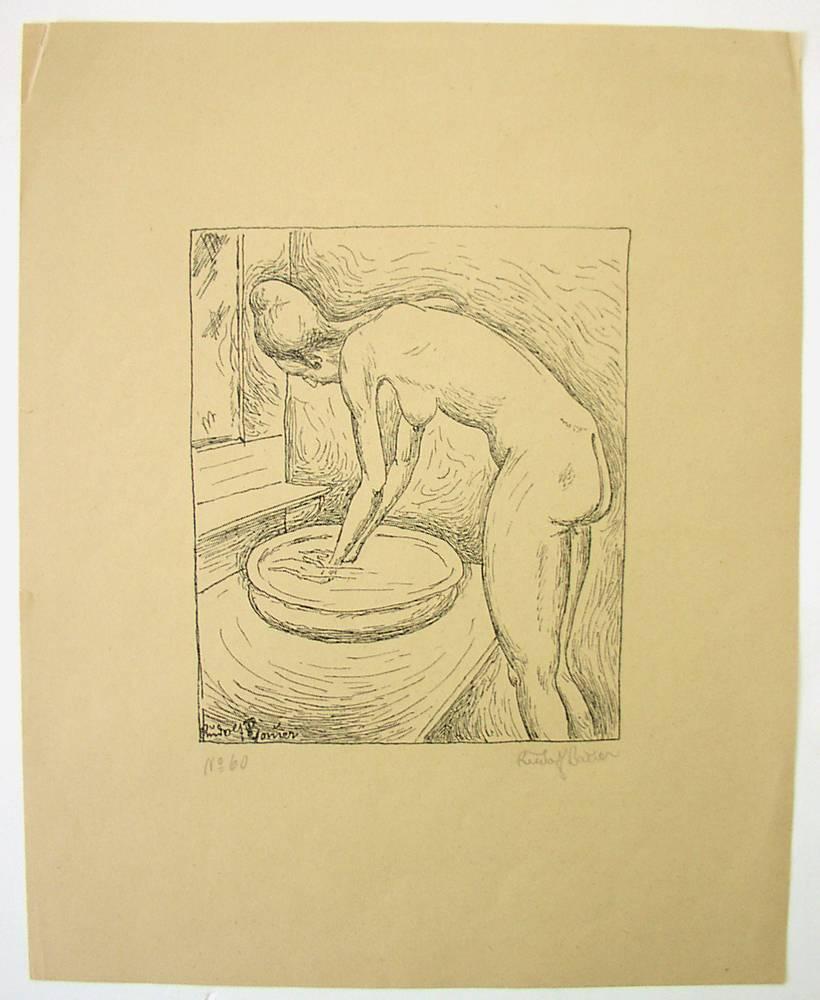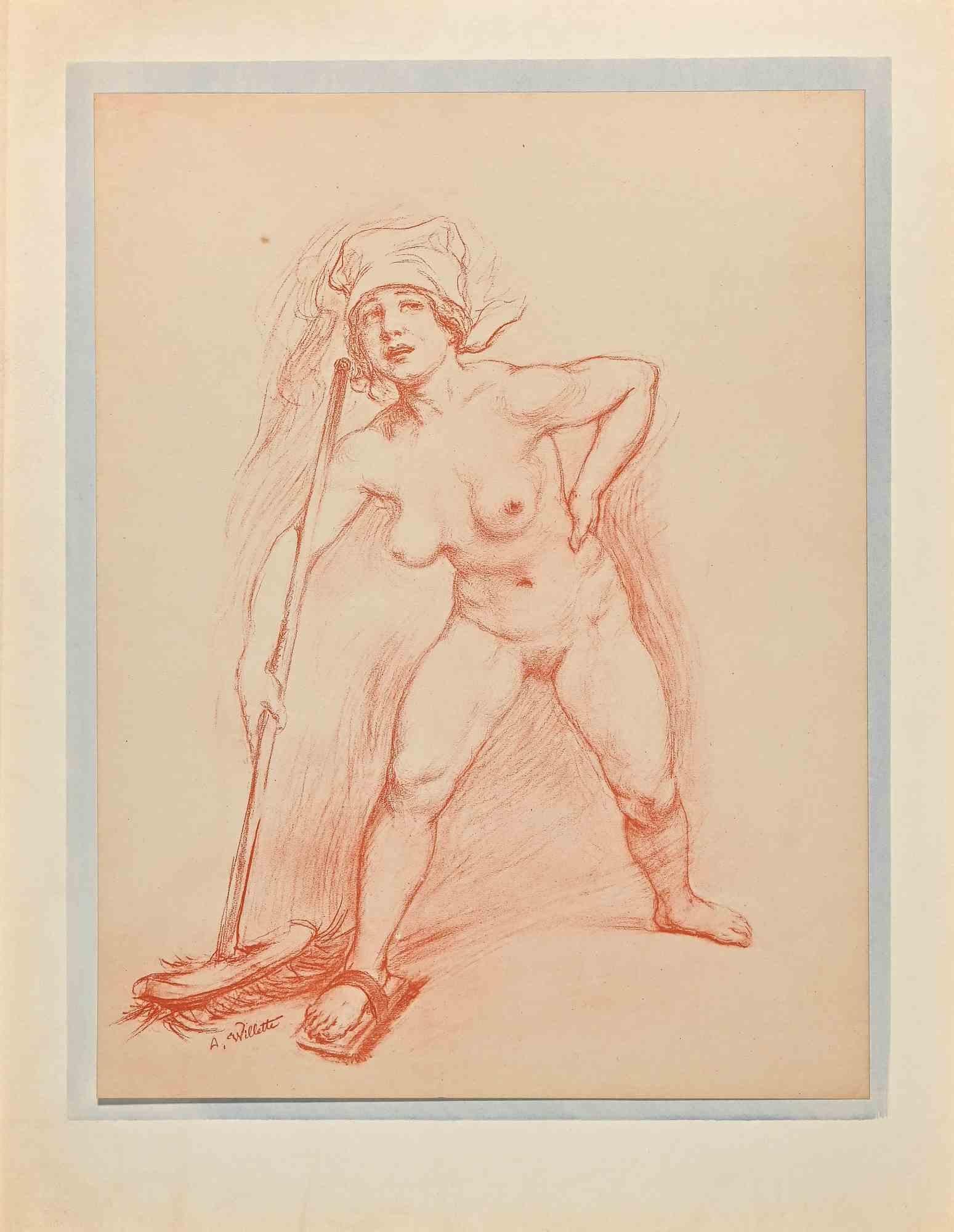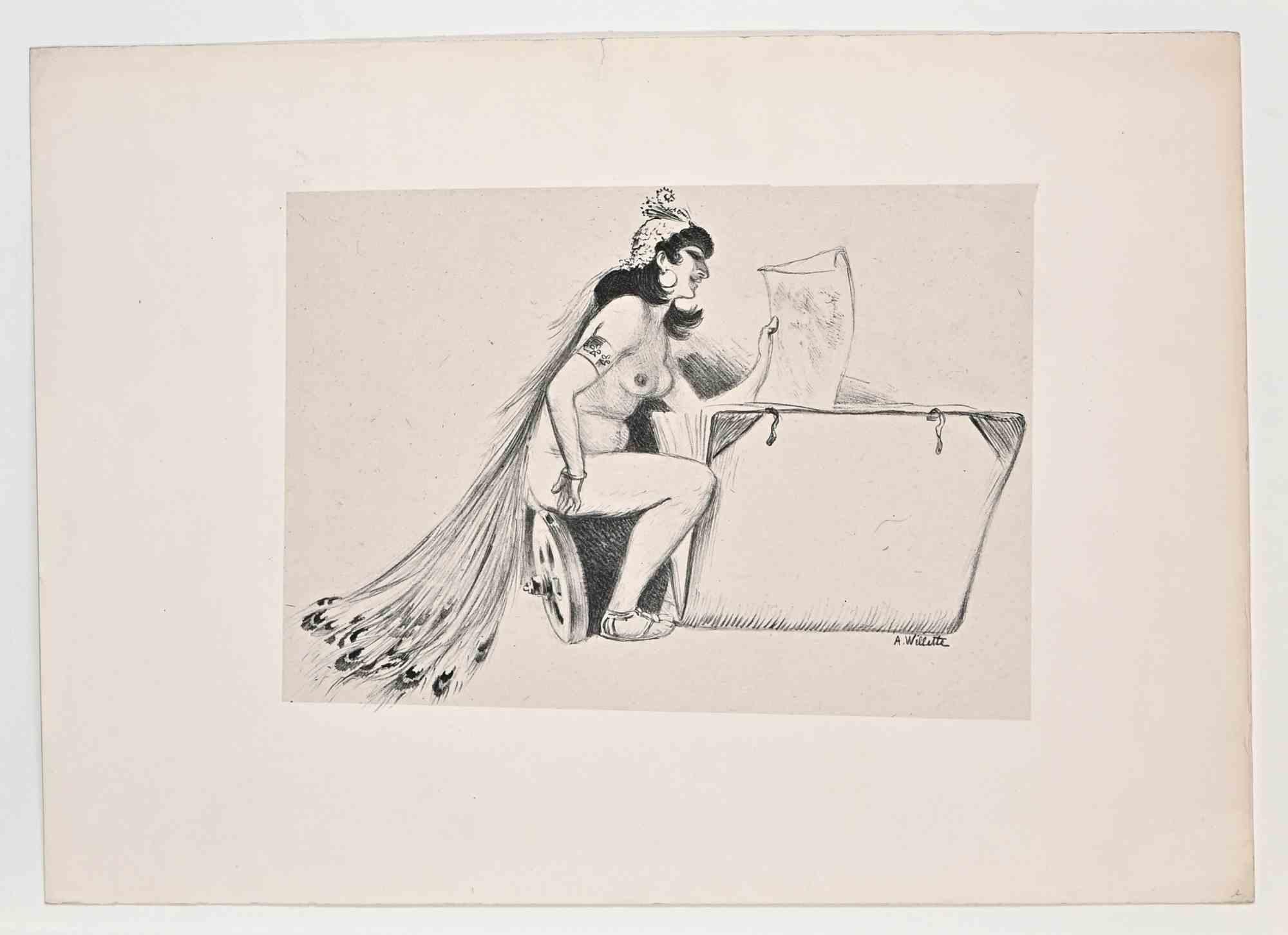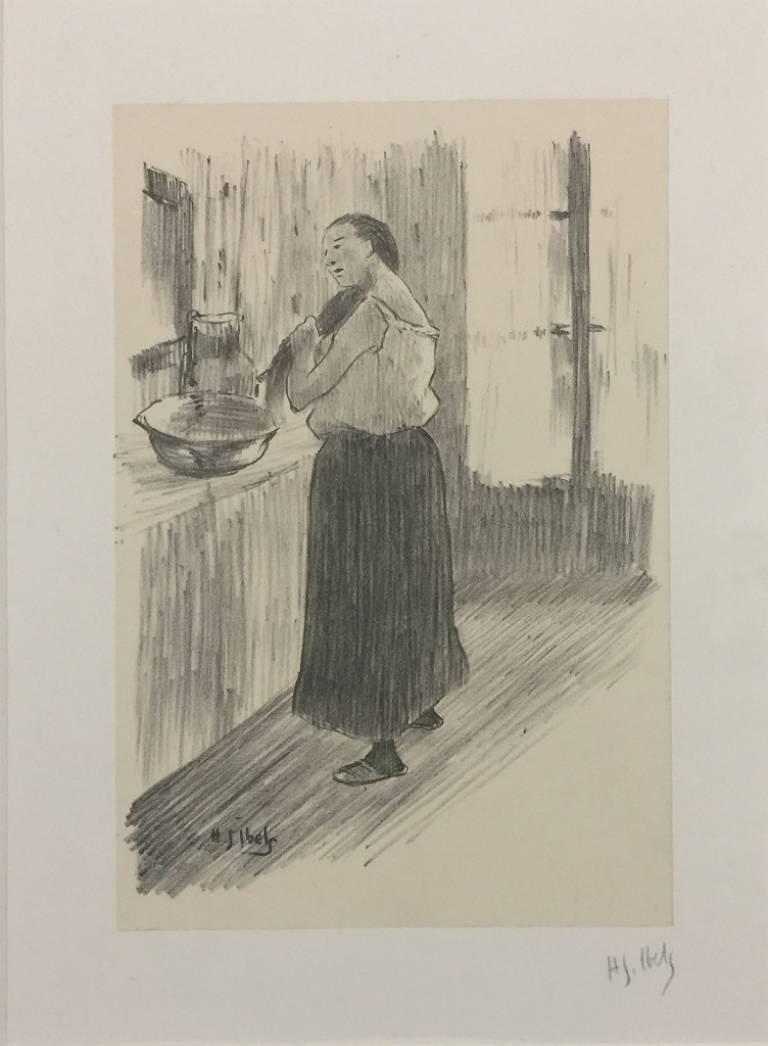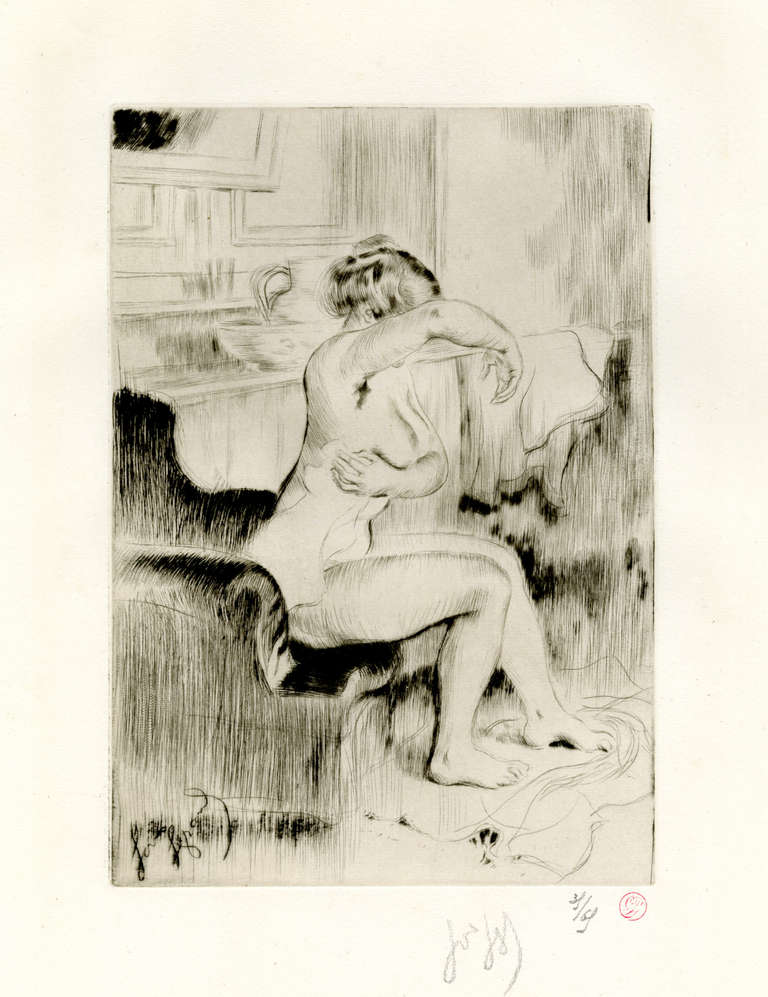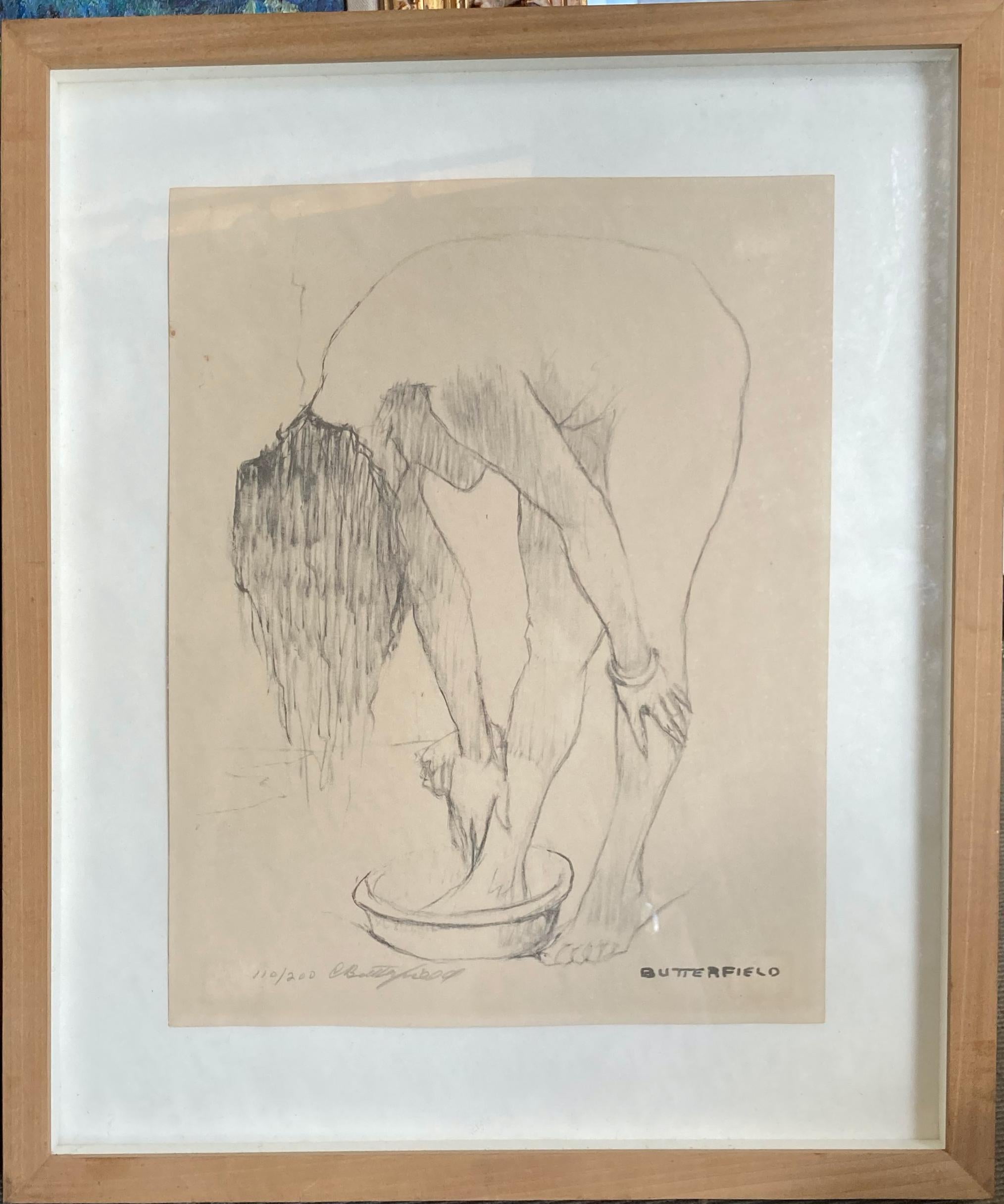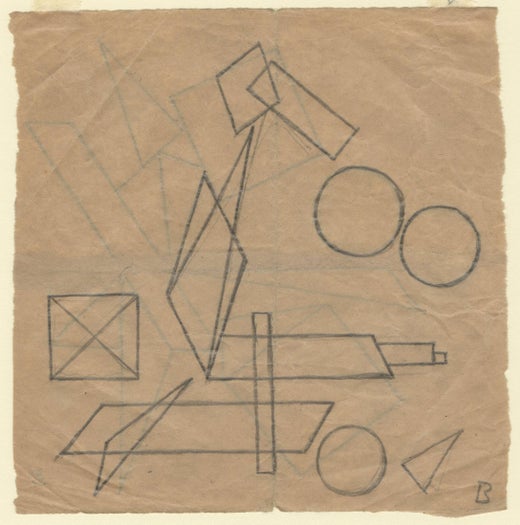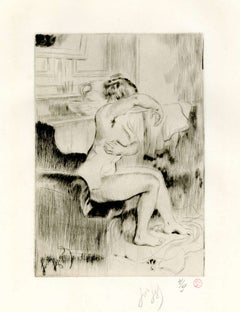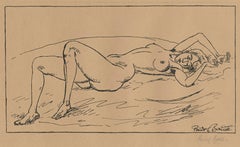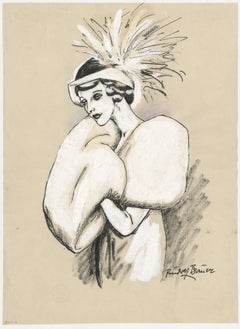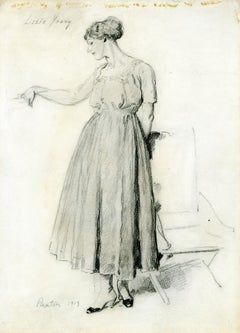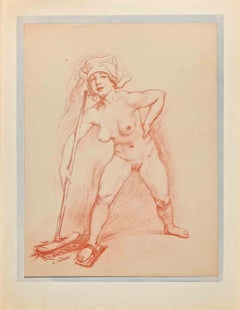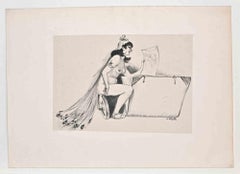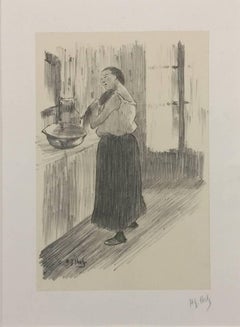Items Similar to untitled (Young Woman Washing)
Want more images or videos?
Request additional images or videos from the seller
1 of 6
Rudolf Baueruntitled (Young Woman Washing)c. 1910
c. 1910
$350
£264.36
€305.52
CA$490.93
A$546.04
CHF 285.78
MX$6,659.87
NOK 3,590.99
SEK 3,377.79
DKK 2,280.41
About the Item
untitled (Young Woman Washing)
Lithograph, c. 1910
Signed in pencil lower right; signed in the plate lower right (see photo)
Image size: 11 x 5-1/8"
Sheet size: 18 7/8 x 12 5/8 inches
Condition: Very good
Aging to the tan paper it is printed on
Provenance: Estate of the Artist
Borghi & Company, NYC
Rudolph Bauer
1889-1953
Rudolf Bauer was born in Lindenwald near Bromberg, Silesia, in 1889 but his family moved only a few years later to Berlin. In 1905 Bauer began his studies at the Berlin Academy of Art but left the Academy only a few months later to educate himself. The upshot was paintings, caricatures and comical drawings which were published in 'Berliner Tageblatt', 'Ulk' and 'Le Figaro'.
From 1912 Bauer contributed to the magazine and Gallery 'Der Sturm' founded by Herwarth Walden and pivotal to German Expressionism and the international avant-garde. In 1915 Rudolf Bauer participated for the first time in a group show at Walden's gallery. There he met Hilla von Rebay, with whom he began a relationship of many years that was crucial to Bauer's later work. By 1922 Bauer had shown work at about eight exhibitions mounted by 'Der Sturm'. From 1918 he also taught at the 'Der Sturm' art school, where Georg Muche was the director. After the war ended, Bauer was a founding member of the 'November Group' although he did not collaborate closely with the group. In 1919 Bauer joined forces with the painter and architect Otto Nebel and with Hilla von Rebay to found the artists' association 'Die Krater'. Impressionist at the outset, Bauer's early work reveals Cubist and Expressionist influences. By 1915/16 Bauer had switched to an abstract pictorial idiom, which is markedly influenced by Kandinsky. In the early 1920s Bauer was also preoccupied with Russian Constructivism as well as the Dutch de Stijl group. Bauer's decided preference for non-representational painting culminated in 1929 with the foundation of a private museum, 'Das Geistreich', which he directed as a salon for abstract art.
Political developments in Germany forced Bauer to sell some of his work in America from 1932. His agent in America was Hilla von Rebay, who was by now director of the Guggenheim Collection. In 1936 she organized a touring exhibition of non-representational European art that included sixty Rudolf Bauer oil paintings and watercolors. After Rudolf Bauer emigrated to the US in 1939, his work was exhibited several times at the Guggenheim Foundation before his death in 1953. Rudolf Bauer's comprehensive œuvre, which had been consigned to virtual oblivion after 1960 in both the US and Europe, has been enjoying a renaissance of interest worldwide since the 1980s.
Courtesy Rudolf Bauer
- Creator:Rudolf Bauer (1889-1953, German)
- Creation Year:c. 1910
- Dimensions:Height: 11 in (27.94 cm)Width: 5.125 in (13.02 cm)
- Medium:
- Movement & Style:
- Period:
- Condition:Aging to the tan paper the lithograph is printed on.
- Gallery Location:Fairlawn, OH
- Reference Number:Seller: FA50871stDibs: LU14013572832
Rudolf Bauer
The true story of Rudolf Bauer is perhaps one of the most complex, tragic, and ironic of 20th century art history. Rudolf Bauer was a pioneering German-born artist who, along with Vasily Kandinsky, was among the first abstract artists in the world. His “non-objective” abstract style would go on to influence virtually all aspects of modern art and serve as a beacon to Pollock, Rothko, and other artists who formed the New York school of Abstract Expressionism. In the first half of the 20th century, Bauer’s works were displayed alongside such luminaries as Picasso, Chagall, Miró, Mondrian, and Kandinsky, in numerous galleries and museums throughout the world. However by the end of World War II, Bauer had stopped painting and fell into obscurity.
About the Seller
5.0
Recognized Seller
These prestigious sellers are industry leaders and represent the highest echelon for item quality and design.
Gold Seller
Premium sellers maintaining a 4.3+ rating and 24-hour response times
Established in 1978
1stDibs seller since 2013
808 sales on 1stDibs
Typical response time: <1 hour
Associations
International Fine Print Dealers Association
- ShippingRetrieving quote...Shipping from: Fairlawn, OH
- Return Policy
Authenticity Guarantee
In the unlikely event there’s an issue with an item’s authenticity, contact us within 1 year for a full refund. DetailsMoney-Back Guarantee
If your item is not as described, is damaged in transit, or does not arrive, contact us within 7 days for a full refund. Details24-Hour Cancellation
You have a 24-hour grace period in which to reconsider your purchase, with no questions asked.Vetted Professional Sellers
Our world-class sellers must adhere to strict standards for service and quality, maintaining the integrity of our listings.Price-Match Guarantee
If you find that a seller listed the same item for a lower price elsewhere, we’ll match it.Trusted Global Delivery
Our best-in-class carrier network provides specialized shipping options worldwide, including custom delivery.More From This Seller
View AllLa Toilette
By Louis Legrand
Located in Fairlawn, OH
La Toilette
Drypoint, 1908
Signed and numbered in pencil by the artist (see photos)
Edition: 65 this state (35/65)
Published by Gustave Pellet (1859-1919),...
Category
Early 1900s Art Nouveau Figurative Prints
Materials
Drypoint
Reclining Nude on Bed
By Rudolf Bauer
Located in Fairlawn, OH
Reclining Nude on Bed
Lithograph, c. 1910
Signed in pencil lower right and in the plate, lower right
Image size: 7-1/4 x 13"
Sheet size: 12 1/2 x 19 inches
Condition: very good
Some aging to the tan paper
Provenance: Estate of the Artist
Borghi & Company, New York
Rudolph Bauer
1889-1953
Rudolf Bauer was born in Lindenwald near Bromberg, Silesia, in 1889 but his family moved only a few years later to Berlin. In 1905 Bauer began his studies at the Berlin Academy of Art but left the Academy only a few months later to educate himself. The upshot was paintings, caricatures and comical drawings which were published in 'Berliner Tageblatt', 'Ulk' and 'Le Figaro'.
From 1912 Bauer contributed to the magazine and Gallery 'Der Sturm' founded by Herwarth Walden and pivotal to German Expressionism and the international avant-garde. In 1915 Rudolf Bauer participated for the first time in a group show at Walden's gallery. There he met Hilla von Rebay, with whom he began a relationship of many years that was crucial to Bauer's later work. By 1922 Bauer had shown work at about eight exhibitions mounted by 'Der Sturm'. From 1918 he also taught at the 'Der Sturm' art school, where Georg Muche was the director. After the war ended, Bauer was a founding member of the 'November Group' although he did not collaborate closely with the group. In 1919 Bauer joined forces with the painter and architect Otto Nebel and with Hilla von Rebay to found the artists' association 'Die Krater'. Impressionist at the outset, Bauer's early work reveals Cubist and Expressionist influences. By 1915/16 Bauer had switched to an abstract pictorial idiom, which is markedly influenced by Kandinsky. In the early 1920s Bauer was also preoccupied with Russian Constructivism as well as the Dutch de Stijl group. Bauer's decided preference for non-representational painting culminated in 1929 with the foundation of a private museum, 'Das Geistreich', which he directed as a salon for abstract art.
Political developments in Germany forced Bauer to sell some of his work in America from 1932. His agent in America was Hilla von Rebay, who was by now director of the Guggenheim Collection. In 1936 she organized a touring exhibition of non-representational European art that included sixty Rudolf Bauer oil...
Category
1910s Jugendstil Nude Prints
Materials
Lithograph
Woman in a Fur Wrap
By Rudolf Bauer
Located in Fairlawn, OH
Woman in a Fur Wrap
Pen and ink heightened with white, c. 1920
Signed in ink lower right (see photo)
Estate stamp verso (see photo)
Provenance: estate of the artist
...
Category
1920s Art Deco Figurative Drawings and Watercolors
Materials
Ink
Preliminary Study for the painting Rose and Gold, 1913
By William McGregor Paxton
Located in Fairlawn, OH
Preliminary Study for the painting Rose and Gold, 1913
Graphite on paper, 1913
Signed in pencil lower left (see photo)
Titlted "Lizzy Young" in pencil upper left (see photo)
Lizzy was a modle that Paxton depicts numerous times.
The painting that this drawing is related to, is illustrated in Lee & Krause, William McGregor Paxton, 1869-1941, Plate 32, text on page 132. The painting was formerly in the collection of Victor Spark and the Honorable Paul Buchanan. It is currently in a Texas Collection.
Provenance: Private Collection, Florida
William McGregor Paxton (June 22, 1869 – 1941) was an American painter and instructor who embraced the Boston School paradigm and was a co-founder of The Guild of Boston Artists. He taught briefly while a student at Cowles Art School, where he met his wife Elizabeth Okie Paxton, and at the Museum of Fine Arts School in Boston. Paxton is known for his portraits, including those of two presidents—Grover Cleveland and Calvin Coolidge—and interior scenes with women, including his wife. His works are in many museums in the United States.
Early life
He was born on June 22, 1869, in Baltimore to James and Rose Doherty Paxton. William's father moved the Paxton family and established a catering business in Newton Corner, Massachusetts, in the mid-1870s.
Education
Paxton attended Cowles Art School on a scholarship he attained at the age of 18. He studied with Dennis Miller Bunker...
Category
1910s American Impressionist Figurative Drawings and Watercolors
Materials
Graphite
Woman Pulling on a Slip
By Everett Shinn
Located in Fairlawn, OH
Woman Pulling on a Slip
Conte on paper, c. 1910
Signed lower right: "E. Shinn" (see photo of legs, signature on right)
Provenance:
Estate of the Artist (see label)
Graham Gallery, N...
Category
1910s Ashcan School Nude Drawings and Watercolors
Materials
Conté
Ecce Homo Plate X
By Werner Drewes
Located in Fairlawn, OH
Ecce Homo Plate X
Woodcut, 1921
Signed, titled, and dated in pencil by the artist (see photos)
Edition: One of two known impressions
This image wwas unknown to the catloger Ingrid Rose in 1984 when she published the catalog raisonne of Drewes prints.
Done while Drewes was studying at the Bauhaus.
Reference: Ingrid Rose, Werner Drewes: A Catalogue Raisonne of His Prints (Munich: Verlag Kunstgalerie Esslingen, 1984), 33, one of two known impressions.
Provenance: Gift of the artist to one of his Bauhaus professors.
Held in East Germany until the opening of the wall
Jorg Maas Kunsthandel, Berlin
Other image from the suite of Ecce Homo images are available.
Extremely early, rare Bauhaus works.
n 1921 Drewes went to the Bauhaus in Weimar, where, after completing the compulsory preliminary course with Johannes Itten, he continued to study with Paul Klee, Oskar Schlemmer and Georg Muche and initially went to the wall painting workshop. He then traveled extensively through Europe, North America and Asia. After returning to Germany in 1927, he went back to the Bauhaus, this time to his new location in Dessau, where he studied in the classes of László Moholy-Nagy and Wassily Kandinsky. He was one of the first artists to introduce the groundbreaking concepts of the Bauhaus School in the United States through his painting, printmaking, and teaching.
Werner Drewes (1899–1985) was a painter, printmaker, and art teacher. Considered to be one of the founding fathers of American abstraction, he was one of the first artists to introduce concepts of the Bauhaus school within the United States. His mature style encompassed both nonobjective and figurative work and the emotional content of this work was consistently more expressive than formal. Drewes was as highly regarded for his printmaking as for his painting. In his role as teacher as well as artist he was largely responsible for bringing the Bauhaus aesthetic to America.
Early life and education
Drewes was born in 1899 to Georg Drewes, a Lutheran pastor, and Martha Schaefer Drewes. The family lived in the village of Canig within Lower Lusatia, Germany. From age eight to eighteen he attended the Saldria Gymnasium, a boarding school in Brandenburg an der Havel. There, he showed talent both for painting and woodblock printing. Graduating from Saldria in 1917, he was drafted by the German army and served in France from then until the close of the war. About this period of his life he is reported to have said that the horrors of life at the front were only made tolerable by his sketchbook, a copy of Goethe's Faust and a volume of Nietzsche.
For a decade following the close of the war he studied, made paintings and prints, and traveled widely. His friend, Herwarth Walden, helped shape his appreciation for expressionist literature and art. Walden produced the quarterly magazine, Der Sturm and ran a gallery of contemporary art, Galerie Der Sturm, from which, in 1919, Drewes purchased an expressionist painting by William Wauer titled Blutrausch (Bloodlust). In the same year he made the acquaintance of Heinrich Vogeler and participated in Vogeler's socialist utopian artists' commune, Barkenhoff, at Worpswede, Lower Saxony. In 1919 Drewes also enrolled at the Königlich Technischen Hochschule Charlottenburg to study architecture and the following year he studied the same subject at the Technischen Hochschule Stuttgart. Preferring art over architecture, he then enrolled in Stuttgart's school of applied arts (Kunstgewerbeschule) where he studied life drawing and learned to work with colored glass. At this time he joined a group of artists and architects associated with the newly formed Merz Akademie, a college of design, art, and media in Stuttgart.
In 1921 his friendship with a French artist, Sébastien Laurent, led him to begin studies in Weimar at Bauhaus, then a new school which taught an integrated approach to the fine and applied arts. His instructors were Johannes Itten and Lyonel Feininger, whose paintings were expressionist and abstract, and Paul Klee, who taught bookbinding, stained glass, and murals. While at Bauhaus Drewes produced a portfolio of ten woodblock prints entitled "Ecce Homo."
In 1923 and 1924 he studied art during travels throughout Italy, Spain, the United States, and Central America and in 1926 he traveled to San Francisco, Japan, and Korea, thence taking the Trans-Siberian railway to Manchuria, Moscow, and Warsaw. He later said the El Grecos he saw proved to be most influential in his work. While traveling, he exhibited: (1) etchings in Madrid (1923) and Montevideo (1924), oils and etchings in Buenos Aires and St. Louis (1925), and (3) etchings in San Francisco (1926). He paid his way by the sales these exhibits produced and by taking commissions to paint portraits. While in San Francisco he set up a shop from which he sold prints he had made in Spain and South America.
After his return to Germany in 1927 he resumed study at Bauhaus, which had been forced to relocate in Dessau, Saxony-Anhalt. His instructors at that time were László Moholy-Nagy (metal work), Wassily Kandinsky, and (painting), and Lyonel Feininger (prints). At this time he also worked and exhibited in Frankfurt. With the rise of Nazism abstract artists found it increasingly difficult to sell their work and, in 1930, Drewes, finding the political pressure unbearable, emigrated to the United States. There, despite the world economic crisis, Drewes was able to earn a living as a professional artist.
Mature style
After Drewes moved to New York, Kandinsky, who was both friend and mentor, continued to exert a strong influence over his style. Later in life he said he had a hard time getting away from Kandinsky's influence as he developed his own style. In time he was able to bring a more emotional approach to his work and to base it, more than Kandinsky did, on natural forms.
In 1930 Drewes had a solo exhibition at the 135th Street Branch of the New York Public Library and a two-person show at the S.P.R. Penthouse Gallery...
Category
1920s Bauhaus Nude Prints
Materials
Woodcut
You May Also Like
La Toilette No. 60.
By Rudolf Bauer
Located in New York, NY
Lithograph printed on tan wove newsprint-type paper. Signed in pencil and in the stone. 15 3/4 x 12 3/4".
Sheet Size: Image Size 8 1/4 x 6 3/4".
Rudolf Bauer (1889-1953) executed hi...
Category
1920s Brücke Figurative Paintings
Materials
Lithograph
Cleaning Nude - Lithograph by Adolphe Willette - Early 20th Century
By Adolphe Willette
Located in Roma, IT
Cleaning Nude is an Original Lithograph realized by Willette (Adolphe Léon).
Good condition on a yellowed paper included a cardboard passpartout (33x25 cm).
Hand signed with sangui...
Category
Early 20th Century Art Nouveau Figurative Prints
Materials
Lithograph
Nude of Woman - Lithograph by Adolphe Willette - Early 20th Century
By Adolphe Willette
Located in Roma, IT
Nude of Woman is an Original Lithograph realized by Willette (Adolphe Léon).
Good condition on a grey paper included a white cardboard passpartout (32.5x48 cm).
Address card for Sa...
Category
Early 20th Century Art Nouveau Figurative Prints
Materials
Lithograph
Femme à la toilette
By Henri Gabriel Ibels
Located in Roma, IT
Hand signed and signed on plate.
A copy of this print is in the collection of the Van Gogh Museum in Amsterdam.
Includes passepartout : 53 x 37cm
Image Dimensions : 23.5 x 15.5 cm
H...
Category
1890s Post-Impressionist Figurative Prints
Materials
Lithograph
"Young Woman Washing" - Signed Framed Late 20th Century Nude Print
Located in New Orleans, LA
A lovely drawing by Cortland Butterfield, signed, in an edition of 200 (this one numbered 110). Professionally float-framed and ready to hang. He...
Category
Late 20th Century Impressionist Nude Prints
Materials
Paper
$296 Sale Price
25% Off
The Bath of Venus - Original Lithograph by F. Bac - 1922
Located in Roma, IT
The Bath of Venus is an original modern artwork realized by Ferdinand Bac (1859 - 1952) in 1922.
Original Lithograph on ivory paper.Image dimensions: 19 x 14 cm.
Signed and dated o...
Category
1920s Art Nouveau Figurative Prints
Materials
Lithograph
More Ways To Browse
Tom Wesselmann Shiny Nude
George De Groat
Trevor Southey On Sale
Vintage Erotica Poster
Anders Leonard Zorn
Guy Ribes
Head Of Lust Rodin
Jerome Ferretti
John Melville Kelly
Nude Lesbian Wall Art
Rooftop Sunbather
Three Graces Salvador Dali
Tracey Emin Grand Hotel
Andy Warhol Poster Torso
Edwina Sandys On Sale
Goyo Hashiguchi
John Lennon Erotic
Joseph Felon On Sale
